
Gamma Ray Bursts (GRBs)
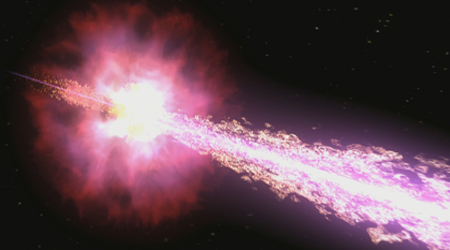
What are Gamma Rays? Gamma rays are extremely high-energy photons, i.e. electro-magnetic radiation greater than 100 keV (100,000 electron volts). Gamma rays are ionizing radiation, and therefore are biologically hazardous and must be avoided by humans. Classically, gamma rays are produced by the decay of atomic nuclei as they transition from a high energy state to a lower state. This is known as gamma decay. (However, gamma rays may also be produced by a few other processes.) Gamma rays are produced by the decay of an atom's nucleus, whereas x-rays are produced by the decay of electrons swirling around the nucleus.
What are Gamma Ray Bursts. Normally lasting anywhere from a few milliseconds to several hours, gamma ray bursts (GRBs) shine hundreds of times brighter than a typical supernova and about a million trillion times as bright as the sun. GRBs are an explosion resulting from either a massive star collapsing into a black hole or two neutron stars colliding instantly forming a black hole. These are known as a long GRB or a short GRB respectively. More long and short GRB details are discusssed in the sections below.
GRBs are for a brief time the brightest source of cosmic gamma ray photons in the universe. GRBs emit more energy in a few seconds than our whole galaxy does in a year. GRBs are observed roughly once per day from completely random directions of the sky. (It was their complete randomness that originally convinced astronomers that GRBs existed outside of our Milky Way.) Note that the label of a GRB indicates its date, i.e. year-month-day, for example, GRB 130427A means it occurred on April 27, 2013 and if there were more than one that day A means it was the first of the day.
We only see a GRB when earth lies along the path of one of the two narrow GRB jets, which means there are many more GRBs each day that we don't see. The nuclear blast emits a surge of gamma rays as well as x-rays, and they produce afterglows that can be observed both at optical and radio wavelengths. No two GRBs are alike, each one has its own individual light curve plotted over time.
AS mentioned above, gamma ray bursts are separated into two classes: long duration bursts and short duration bursts. Long duration bursts last more than 2 seconds and short duration ones last less than 2 seconds. However, short duration bursts range from a few milliseconds to 2 seconds with an average duration time of only 0.3 seconds (300 milliseconds). The long duration bursts normally last anywhere from 2 seconds to a few hours with an average duration time of about 30 seconds. Scientists believe that the two types of bursts have completely different sources. They are not small and large versions of the same phenomenon. Top
What is the Long GRB's Source Of Energy?
Most long duration gamma ray bursts originate near the farthest edges of the observable universe. The stars linked to them are typically billions of light years away. These stars are so far away that we don't actually see the light from them before they explode. They belong to an early generation of stars (e.g. maybe second or third generation) in the universe. Although such stars died long ago, only now is the light from their explosive deaths reaching us.
Because GRBs come from very far away, live for only a few minutes, and are very hard to observe, scientists have had a hard time determining the source of their energy. Scientists know of a class of stars called "Wolf-Rayet" (WR) stars that are very massive (20+ times our sun) and have a surface temperature of 45,000 degrees Fahrenheit, significantly hotter than the sun's 10,000 degree Fahrenheit surface temperature. They are also surrounded by an "atmosphere" of very hot gas that is about the same volume as the star itself. Because WR stars burn so brightly and erratically, they have very short life spans. A typical WR life span is just a few million years compared to the billions of years for more stable stars like our sun.
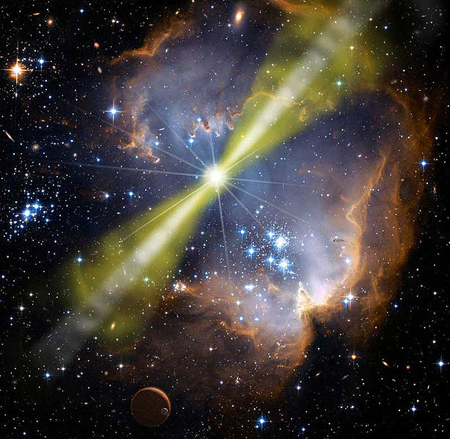
When a WR star dies, it often undergoes a supernova explosion. Some of these supernovas are sufficiently energetic to be classified as a "hypernova", 100 plus times more energy than a standard supernova. Theory predicts that some of these hypernovas are accompanied by a gamma ray burst as the core undergoes a step by step gravitational collapse into a new black hole. Astro-physicists believe that gamma rays are produced from magnetic waves while still inside the star. Theory states that the explosion originates at the center of these massive stars. While a black hole is forming from the collapsing core, the concurrent explosion sends a blast wave moving through the star at speeds close to the speed of light.
Gamma rays are created when the blast wave collides with material still inside the star. These gamma rays then burst out from the star's surface just ahead of the blast wave. Erupting through the star's surface, the blast wave of stellar material sweeps through space at nearly the speed of light, colliding with external gas and dust, producing additional emissions of radiation. These emissions are believed to be responsible for the "afterglow" of progressively less energetic photons starting with x-rays and then visible light and radio waves. See a NASA video of a long gamma ray burst here.
Definitive proof of the supernova link to long GRBs came in March, 2003, when a relatively nearby burst, GRB 030329, produced an afterglow whose optical spectrum was almost identical to a supernova spectrum. X-ray observations also showed a signature associated with oxygen heated up to high temperatures. This signature pattern occurs when a supernova blast wave excites oxygen atoms in the vicinity of the explosion.
A supernova producing a GRB channels most of its energy along the twin jets. See the artist Lynette Cook's illustration above. Note that in the illustration there is a narrow central beam surrounded by a much wider beam. Also note that there is no accretion disk. This image was a result of a model developed to explain gamma ray burst GRB 080319B." Top
What is the Short GRBs Source Of Energy?
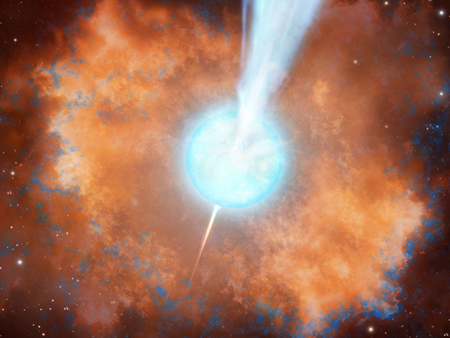
Astro-physicists think that long and short duration GRBs are created by fundamentally different physical processes. Whereas they are fairly confident of what drives long GRBs, until very recently there are only theories when it comes to what drives short duration bursts. Short duration bursts account for about 30% of gamma ray bursts. But until 2005, no afterglow had been successfully detected from any short event and little was known about their origins. Since then, several dozen short gamma ray burst afterglows have been detected. However, several of these short bursts were found in regions of space with little or no star formation. This ruled out a link to massive stars, confirming that short events are physically distinct from long events. In addition, there has been no other type of association with supernovas.
The leading hypothesis is that short duration bursts originate from mergers of binary neutron stars. A neutron star is 10 miles or less in diameter and made almost entirely of tightly packed neutrons. Atoms that make up normal "solid" matter are mostly empty space. But a star packed with just neutrons, the nuclei of normal atoms, is extraordinarily dense. A spoonful of a neutron star would have a mass of more than a trillion pounds. A neutron star's density and gravity is second only to a black hole. When two of these extremely heavy, hard objects crash, you have a mighty big explosion.
The mean duration of these neutron crashes (0.3 seconds) suggests a source with a very small diameter, i.e. less than 5% of the sun's diameter. This alone suggests a very compact object as the source. The observation of a gamma ray burst lasting less than a second is consistent with two neutron stars colliding, instantly forming a black hole and creating short lived gamma ray jets. The crash would be followed by minutes to hours of "x-ray flashes" of lesser energy events as the remaining fragments of star material continued to spiral into the black hole. In 2009 a simulation model done at NASA's Marshall Space Flight Center in Huntsville, Alabama, suggested that the collision of two neutron stars would result in a black hole with extremely powerful magnetic jets providing the exit for mass amounts of gamma rays and other radiation. Top
Kilonovas Are Discovered
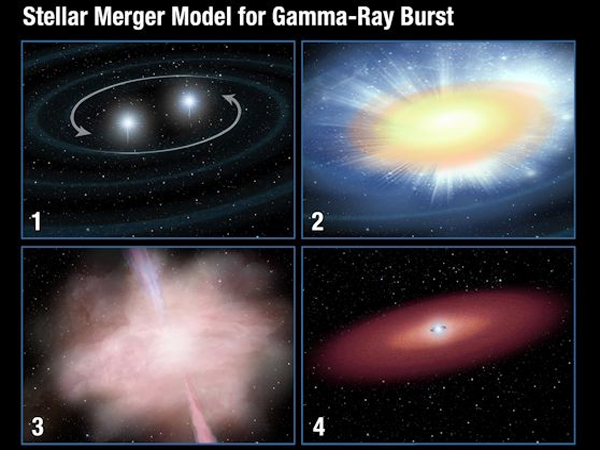
In June, 2013, the Hubble Space Telescope detected a new kind of stellar blast called a "kilonova", which happens when a pair of neutron stars crash together. (A normal "nova" is a violent nuclear explosion of a white dwarf star.) The sequence to the left illustrates the kilonova model for the formation of a short duration gamma ray burst: 1) A pair of neutron stars in a binary system spiral together. 2) In the final milliseconds, as the two objects merge, they kick out highly radioactive material. This material heats up and expands, emitting a burst of light called a kilonova. 3) The fading fireball blocks visible light but radiates in infrared light. 4) A remnant disk of debris surrounds the merged object, which probably has collapsed to form a black hole (source: NASA).
Astro-physicists had predicted that short GRBs are created when a pair of super dense neutron stars in a binary system spiral together. This happens because it is thought the binary system emits gravitational radiation, creating tiny waves in the fabric of space-time. The energy dissipated by the waves causes the two stars to continuously sweep closer together. In the final milliseconds before the explosion, the two stars merge into a death spiral that expels highly radioactive material. This material heats up and expands, emitting a huge burst of light. The resulting kilonova is about 1,000 times brighter than a regular supernova, which is caused by the collapse of a white dwarf star.
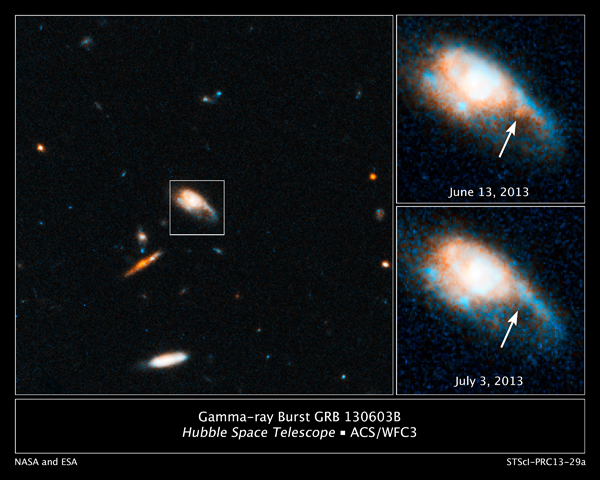
In a recent science paper Jennifer Barnes and Daniel Kasen of the University of California at Berkeley and the Lawrence Berkeley National Laboratory presented new calculations predicting how kilonovas should look. They predicted the same hot plasma producing the radiation also will block the visible light, causing the gusher of energy from the kilonova to flood out in near-infrared light over several days.
On June 3, 2013 NASA's Swift space telescope picked up the extremely bright gamma ray burst, GRB 130603B. Although the initial blast of gamma rays lasted just one-tenth of a second, it was roughly 100 billion times brighter than the subsequent kilonova flash. From June 12 to 13th, Hubble searched the location of the initial burst, spotting a faint red object. An independent analysis of the data from another research team confirmed the detection. Subsequent Hubble observations on July 3 revealed the source had faded away, providing the key evidence that the infrared glow was a result of the explosion from the merger of the two neutron stars (source: NASA).
"We only had weak circumstantial evidence that short bursts might be produced by the merger of these compact objects," said Nial Tanvir of the University of Leicester, UK, leader of the research team. "This result now provides definitive proof" he added. Top
A Kilonova Is "Seen" and "Heard"
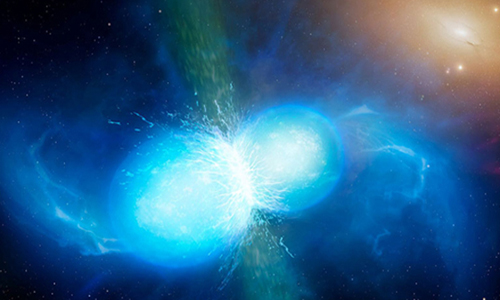
On the morning of August 17, 2017, a ripple in space passed through our planet. It was "heard" by the two LIGO and single Virgo "gravitational" wave detectors. This cosmic disturbance, a kilonova, came from a pair of neutron stars colliding at one third the speed of light. See the NASA artist's conception of the kilonova collision to the left.
When neutron stars slam together, all kinds of things burst out in addition to visible light: gamma rays, x-rays, and radio waves. Transformed into sound, the gravitational signal was a long 100-second chirp, that ended in a sudden whoop up to 1000 cycles per second, two octaves above middle C. This very high frequency indicated that the source was lighter than two black holes colliding.
Meanwhile, the Fermi Gamma Ray Space Telescope, which orbits earth looking for the highest energy radiation in the universe, recorded a brief flash of "gamma rays" just two seconds after the LIGO chirp. Fermi sent out its own alert to astronomers. The gamma ray burst lasted about two seconds, which put it in a category of short gamma ray bursts, which astronomers recognized as two neutron stars colliding.
Learning about the collision from the fast moving gravitational waves, astronomers around the world jumped into action. Telescopes large and small scanned the patch of sky where the gravitational waves came from. The three gravitational wave detectors had been able to triangulate the exact sky position. (Note that the speed of gravitational waves from the theory of relativity is equal to the speed of light in a vacuum,"c". In the theory of relativity, the constant "c" is not exclusively about visible light, it is the highest possible speed for any type of interaction in a vacuum.)
Twelve hours later, visual telescopes caught sight of the kilonova in the galaxy called NGC 4993, about 130 million light years from earth. When it was first identified, the fireball of 8,000-degree gas was about the size of Neptune’s orbit and radiating about 200 million times as much energy as the sun. In Chile, the Gemini telescope swerved its large 26-foot mirror to the kilonova. NASA steered the Hubble to the same location. This was the first time a kilonova was both "heard" by gravitational waves, then quickly located and "seen" by visual telescopes. (It convinced some doubters that gravitational waves were really "real".)
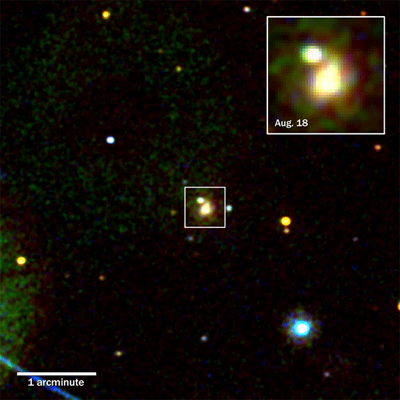
The kilonova was visible in ultraviolet light, as recorded by NASA's Swift telescope. See the actual Swift photo to the left taken on August 18th. The kilonova is the small, white speck immediately above and to the left of the bright galaxy NGC 4993 in the center of the photo. (The upper right insert is a magnified view of the galaxy and the kilonova.)
The Swift ultraviolet and optical telescope imaged the event about 15 hours after other observatories detected the gravitational waves and the gamma ray burst on August 17. Just 12 days later, on August 29, the kilonova faded and became undetectable in ultraviolet light. (The image to the left uses false colors and is based on data from images taken from three ultraviolet filters.)
Within two weeks the visible light faded away, leaving behind a warm infrared glow, which eventually disappeared as well. But in this fading light was encoded the answer to the age old question of how gold and other heavy elements are formed.
Shine sunlight through a prism and you will see our sun’s spectrum – the colors of the rainbow spread from short wavelength blue light to long wavelength red light. This spectrum contains the fingerprints of all the elements that are formed inside the sun. Each element is marked by a unique fingerprint of a line in the sun's spectrum.
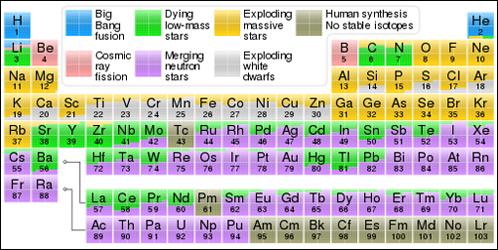
Likewise, the spectrum of a kilonova contains the fingerprints of the heaviest elements in the universe. Its light carries the telltale signature of the neutron-star material decaying into platinum, gold and many other heavy elements. See the periodic table to the left which is color coded by the source of all the elements. Note the large number of "purple" items that result from the collision of two neutron stars - a kilonova.
As of April 2018, there have been six confirmed gravitational wave events announced by the LIGO and Virgo collaborations. However there are, according to Eric Thrane and Rory Smith from the ARC Centre for Gravitational Wave Discovery, more than 100,000 gravitational wave events every year too faint for LIGO and Virgo to unambiguously detect. The gravitational waves from these mergers combine to create a "gravitational wave background". While the individual events that contribute to it cannot be resolved individually, researchers have sought for years to detect this quiet gravitational wave hum.
In a landmark paper in the journal, Physical Review X, the two above researchers have developed a new, more sensitive way of searching for the gravitational wave background. "Measuring the gravitational wave background will allow us to study populations of black holes at vast distances. Someday, the technique may enable us to see gravitational waves from the Big Bang, and those hidden behind gravitational waves from black holes and neutron stars," Thrane said. Top
Gamma Ray Burst Summary
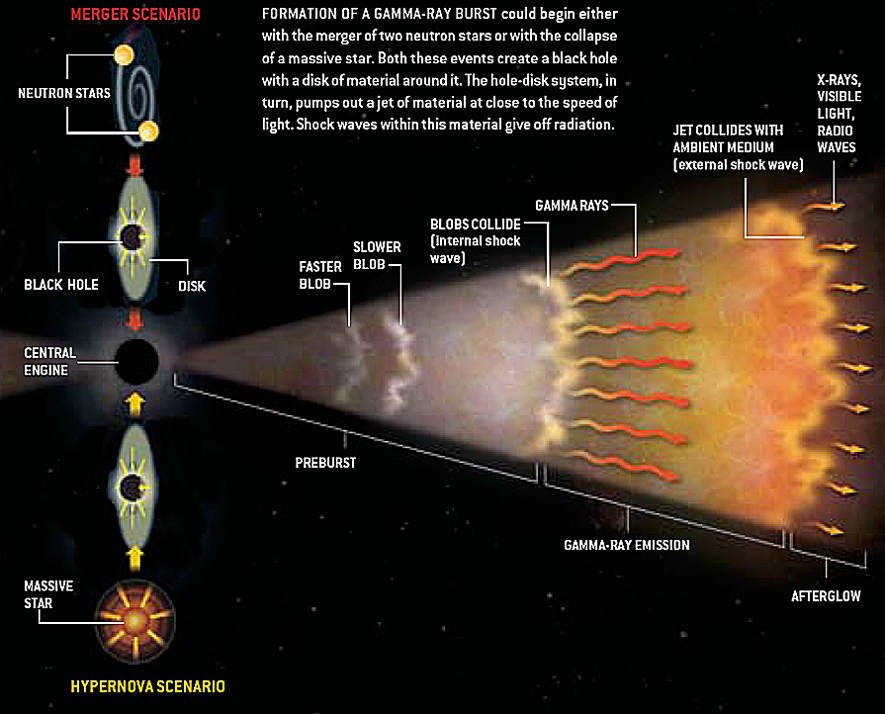
NASA Gamma Ray Satellites:
Swift Satellite
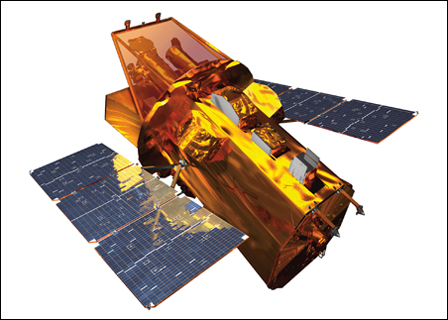
The Swift satellite was launched in 2004 with a mission to quickly detect Gamma Ray Bursts (that frequently have very short life cycles) with its Burst Alert Telescope (BAT). Also part of its mission is to quickly adjust its two telescopes to locate the GRB and capture not only the blast, but also the after glow. Within seconds of detecting a burst, Swift relays its location, allowing both ground-based and space-based telescopes around the world to observe the burst and its afterglow.
To track these mysterious bursts, Swift carries a suite of three main instruments. The Burst Alert Telescope (BAT) instrument, built by the Goddard Space Center, will detect and locate about one gamma-ray burst a day, relaying a rough position to the ground within 20 seconds. The satellite will swiftly re-position itself to bring the burst area into the narrower fields of view of the on-board X-ray Telescope (XRT) and the UltraViolet/Optical Telescope (UVOT). These telescopes study the afterglow of the burst produced by the cooling ashes that remain from the original gamma ray explosion.
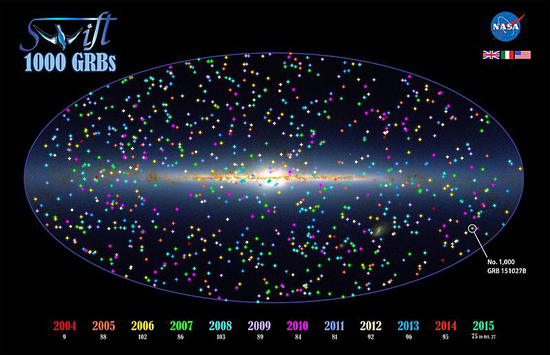
To the left is a map of the sources of 1000 GRBs detected by the Swift satellite through 2015. The XRT and UVOT instruments determine the precise position of the GRB and measure the spectrum of its afterglow from visible to X-ray wavelengths.
For most of the bursts detected, Swift data, combined with observations by ground-based telescopes, enable the measurement of the distance to the burst source. The afterglow phenomenon can linger in X-ray light, optical light, and radio waves for hours to weeks, providing detailed information about the burst.
Swift will check in on bursts regularly to study the fading afterglow as will ground-based optical and radio telescopes. The crucial link is having a precise location to quickly direct other telescopes to the burst. Top
.Fermi Satellite
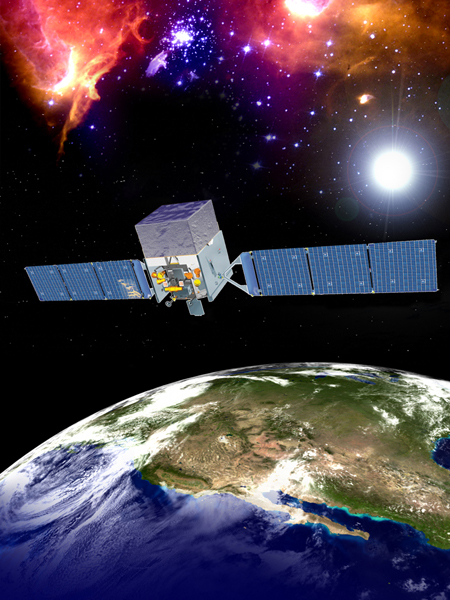
The Fermi satellite was launched in June 2008 to complement the Swift satellite launched in 2004 with a more sophisticated set of instruments. It was originally called GLAST, the Gamma-ray Large Area Space Telescope. It was renamed Fermi in August, 2008 in honor of Enrico Fermi, a pioneer in high-energy physics. Fermi catches photons with energies hundreds of billions of times greater than those that we see with our eyes.
Fermi's overall mission is to to perform gamma ray research from a low circular satellite orbit. It circles the earth every 95 minutes or about 16 times a day. Its normal mode of operation keeps an orientation so that the instruments look away from the earth with a rocking motion to sweep across the sky. The spacecraft can also maintain an orientation that points to a given target.
Fermi contains two major instruments: the Large Area Telescope (LAT) and the Gamma-ray Burst Monitor (GBM). The main instrument, the gamma-ray LAT, is vastly more capable than instruments in previous satellites. The LAT, has a superior area, good angular resolution, and a large field of view, that all together provides at least a factor of 30 times improvement in sensitivity. It also has the capability to study transient phenomena, such as solar flares. The LAT's field of view covers about 20% of the sky at any time and it scans continuously, covering the whole sky every three hours.
Fermi also has a secondary instrument to augment the LAT - the Gamma-ray Burst Monitor (GBM) . The purpose of the GBM is to determine that a GRB has been detected, to quickly calculate the exact coordinates of it, and to immediately pass the location on to the LAT. The Gamma-ray Burst Monitor has a field of view several times larger than the LAT and extends the lower energy limit of the LAT coverage. Its detectors are on the sides and top of the spacecraft in order to view all of the sky which is not blocked by the earth. The GMB has also detected gamma rays in the earth's atmosphere that have been generated by powerful thunderstorms. Top
.The Largest Gamma Ray Burst Ever - GRB 130427A
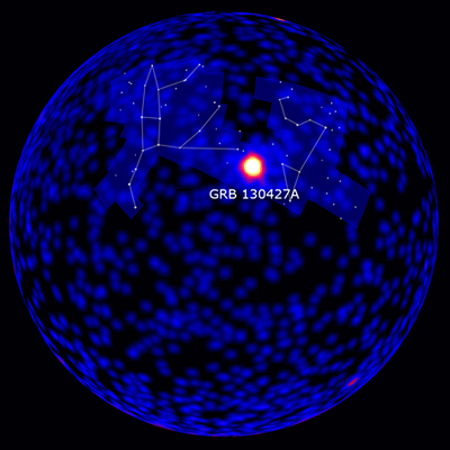
A record setting gamma ray burst has amazed astro-physicists around the world. The image to the left and below is GRB 130427A which occurred on April 27, 2013. The image to the left shows how the sky, at gamma ray energies "above" 100 million electron volts, looked when GRB 130427A occurred. The burst was initially detected by the Swift satellite that specializes in gamma ray bursts and quickly notifies other satellites and observatories on the ground. The burst was so bright that the Fermi gamma ray satellite abandoned its normal surveying mode to give its Large Area Telescope (LAT) an extended view. The GRB lasted so long that a record number of ground based telescopes were able to catch it while space based observations were still in process. Because of the rapid location positioning by Swift, it was also analyzed in optical, infrared and radio wavelengths by the ground based observatories.
Astronomers quickly calculated that the GRB was about 3.6 billion light-years away, which for GRBs is relatively close and pretty rare. After analyzing the light produced by the GRB, scientists determined that the original star was only three to four times the size of the sun, but was 20 to 30 times more massive. This extremely compact star was also rotating very rapidly.
"We expect to see an event like this only once or twice a century, so we're fortunate it happened when we had the appropriate collection of sensitive space telescopes with complementary capabilities available to see it," said Paul Hertz, director of NASA's Astrophysics Division.
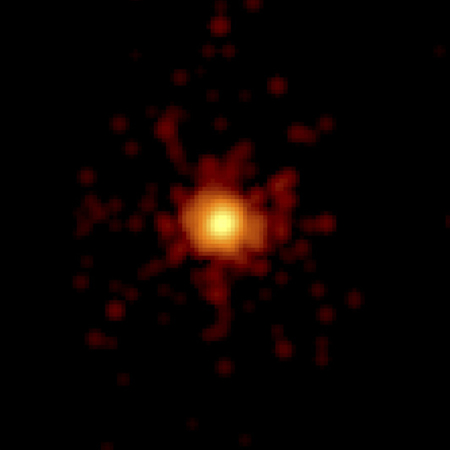
In its first three seconds alone, the monster burst proved brighter than any burst previously observed. Fermi's Large Area Telescope (LAT) recorded its peak energy at 94 billion electron volts, or some 35 billion times the energy of visible light. GRB 130427A was about three times more energetic than the previous record from 2009 held by GRB 090219. The output from GRB 130427A was visible in gamma rays by the LAT for an amazing 20 hours, while typical GRBs fade within minutes or at most a few hours.
If the GRB is close enough, astronomers usually discover a supernova at the site a week or so after the outburst. The close GRB proximity to earth enabled astronomers to confirm for the first time that one object can create both a powerful GRB and a supernova explosion.
"The spectacular results from Fermi's Gamma-ray Burst Monitor (GBM) show that our widely accepted picture of gamma rays from internal shock waves is woefully inadequate," said Rob Preece, a Fermi team member at the University of Alabama in Huntsville who led the study. "We thought the visible light for these flashes came from internal shocks, but this burst shows that it must come from the external shock, which produces the most energetic gamma rays," said Sylvia Zhu, a Fermi team member at the University of Maryland in College Park.
GRB 130427A triggered dynamic internal and external shock waves that are still not entirely understood. Though scientists have a clearer view of the violent explosion, mysteries remain. For example:
-
Space telescopes detected more photons and more high energy gamma rays than theoretical models predict for a gamma ray burst of this magnitude.
-
Ordinarily one might expect the gamma ray photons with the highest energy to appear immediately following the star's explosion. But with GRB 130427A, some of the highest energy photons, including the record holder burst, appeared hours after the blast.
-
GRB 130427A gamma rays and emissions at visible wavelengths brightened and dimmed in tandem. This was quite unexpected because current theory suggests that they come from different regions of the expanding shells of exploded materials and should have peaked and dimmed at different times.
-
Finally, theorists had posited different mechanisms for generating gamma rays and X-rays that are part of a long duration gamma ray burst. The result should have been a fade out for the two forms of light punctuated by periods where emissions were interrupted. Instead, the two sets of rays dimmed smoothly.
These results will most likely lead to more refined theories of how GRBs explode. "The really cool thing about this GRB is that because the exploding matter was traveling at nearly the speed of light, we were able to observe relativistic shocks," said study coauthor Giacomo Vianello, a postdoctoral scholar at Stanford University. "We cannot make a relativistic shock in the lab, so we really don't know what happens in it, and this is one of the main unknown assumptions in the models. These observations challenge the models and can lead us to a better understanding of the physics." Top
Ultra Long GRBs are Driven by Magnetars
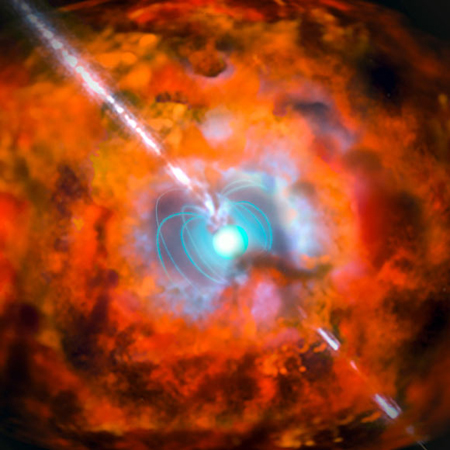
Analysis of data from the European Southern Observatory (ESO) in Chile has for the first time demonstrated a link between an ultra long lasting burst of gamma rays and an unusually bright explosive decay of a star into a magnetar. This ultra long duration GRB was picked up by the Swift satellite on December 9, 2011, and named GRB 111209A. The results were analyzed in depth and published in Nature in July, 2015. See the artist's rendition of a magnetar to the left. Note the blue lines which represent the extreme spining magnetic field that surrounds a magnetar.
The ESO results show that the radiation following GRB 111209A was not driven by radioactive decay, as expected, but was instead powered by the decaying super-strong magnetic fields around a magnetar. A magnetar is a tiny neutron star spinning a few hundred times per second and possessing a magnetic field very much stronger than normal neutron stars.
GRBs usually last only a few seconds, but in very rare cases the gamma rays continue for hours. “Since a ultra long duration gamma ray burst is produced only once every 10,000 to 100,000 supernovas, the star that exploded must be somehow special,” said Jochen Greiner from the Max Planck Institute in Germany.
“Astronomers had assumed that these GRBs came from the collapse of very massive stars, about 50 times the mass of the sun, and that they signaled the formation of a black hole. But our new observations in the aftermath of GRB 111209A are changing this paradigm for ultra long duration GRBs” said Greiner.
In the most popular scenario of a massive star collapse, the burst of emission from the supernova is expected to come from the decay of radioactive nickel-56 formed in the explosion. But in the case of GRB 111209A, the observations showed unambiguously for the first time that this could not be the case. The only explanation that fit the observations following GRB 111209A was that it was being powered by a magnetar.
Magnetars are the most strongly magnetized objects in the known universe. This is the first time that such an unambiguous connection between a gamma ray burst and a magnetar has been recorded. As of May of 2014, there were only 24 known magnetars in the observed universe with 2 more candidates in line for confirmation. For more information on magnetars, see What Exactly Is A Magnetar?